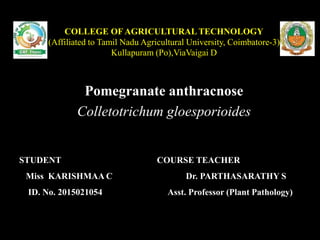ANTHRACNOSE OF POMEGRANATE
- 1. COLLEGE OF AGRICULTURAL TECHNOLOGY (Affiliated to Tamil Nadu Agricultural University, Coimbatore-3) Kullapuram (Po),ViaVaigai D Pomegranate anthracnose Colletotrichum gloesporioides STUDENT Miss KARISHMAA C ID. No. 2015021054 COURSE TEACHER Dr. PARTHASARATHY S Asst. Professor (Plant Pathology)
- 2. INTRODUCTION âĒ Pomegranate anthracnose is a severe disease in karnataka it causes spotting and rot of pomegranate fruit leading to decrease in price and quality.
- 3. Taxonomic classification Kingdom: Fungi Phylum : Ascomycota Class :Sordariomycetes Order : Incertae sedis Family : Glomerellaceae Genus :Colletotrichum Species : C gleosporioides
- 4. Occurrence and distribution âĒ This organism is found worldwide in almost all the countries particularly in perennials in tropical regions.
- 5. History âĒ Colletotrichum gleosporioides was first isolated from Trinidad and Mexico. âĒ Butler (1918) reported colletotrichum gleosporioides for the first time in India causing leaf spot in coffee.Mc Rae reported it as causitive agent for mango anthracnose.
- 6. Host âĒ Citrus, yam, papaya, avocado, coffee, eggplant, sweet pepper and tomato.
- 7. Favourable conditions âĒ High temperature and high humidity are favourable for the growth of the pathogen. âĒ Germination of the spores require high humidity. âĒ when the moisture content is high acervuli is able to release spores. âĒ The fungus is not active during dry weather.
- 8. Symptoms âĒ Small , regular to irregular black spots on leaves, calyx region and fruits which turn later on as dark brown depressed spots. âĒ Infected leaves turn yellow and drop off.
- 11. Mode of spread âĒPrimary spread : Infected leaves âĒSecondary spread :Wind borne conidia
- 13. Chemical management âĒ Carbendazim /Difenconaole or Thiophanate methyl @ 0.1%. âĒ Chlorothalonil 0.2% spray at forty night intervals. âĒ Spraying of Prochloraz 45 EC @ 0.75ml/lit were effective against anthracnose.
- 14. Biological management âĒ Known biocontrol agents are competitive fungi Aspergillus flavus, Hypocrea rufa, Hyponectria tuberculariformis and Nectriella muelleri.
- 15. References âĒ H.W. Anderson, âDiseases of Fruit Crops â, 2nd edition, J.V Publishing house. Pg (172 â 173) âĒ T.S. Thind , âDiseases of Fruit and Vegetabes and their Management, Kalyani Publishers.Pg(26 â 30) âĒ www.agriportal.com














